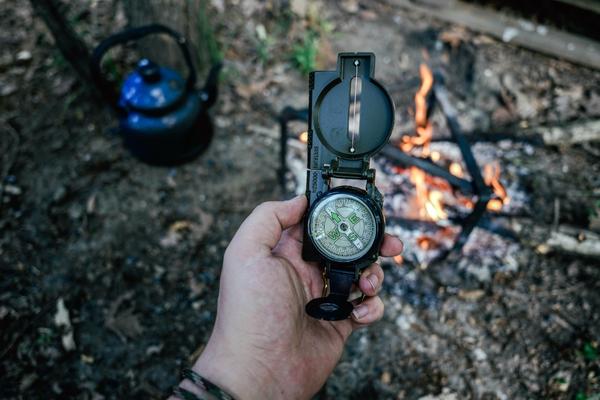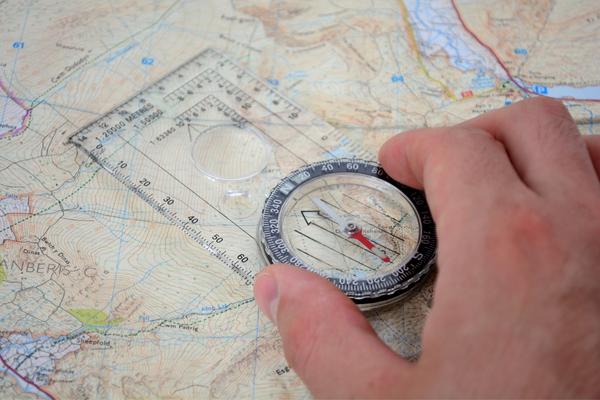How To Properly Use A Compass
Are you new to camping or backpacking and not sure how to use a compass? If so, you’ve come to the right place! Using a compass may sound like an intimidating task, but with the right direction, it can be quite simple. Today we will provide you with all of the tools and knowledge necessary for understanding the basics of using a compass. We’ll cover topics such as how compasses work, orientation principles essential for navigating your way around when exploring outdoors, and some basic map reading techniques. So let’s get started learning all about compasses!

What is a compass and what does it do
For over a thousand years, the compass has been an invaluable asset to adventurers of every kind. Its guidance still assists travelers to their destinations today. By harnessing the power of a compass, one can easily find their bearings in relation to Earth’s magnetic field. Compasses provide travelers with an invaluable tool, as they are able to show the cardinal directions – north, south, east and west – by pointing towards the North Pole. This allows for accurate navigation to any destination of your choice! Compasses are essential for any kind of navigation, be it land or sea. Not only that, compasses can aid in calculating angles and distances on maps with precision! By understanding how compasses work and the principles behind them, you can make sure they reliably keep their bearings in any situation.
The different parts of a compass
A compass consists of four basic parts that work together to determine directions – the needle, the magnetized compass dial (often referred to as the face), a sighting line, usually called an ‘azimuth ring’ and a rotating bezel. The compass needle is a thin rod that’s made of metal and magnetized at one end so it points towards the magnetic North Pole. It’s located on the compass dial and rotates on an axis. The azimuth ring has degree markings along its circumference which can help determine direction or orientation. Finally, the rotating bezel helps with accurately measuring directional bearings while also providing some protection for the compass needle. All these elements combine to help you navigate yourself through unfamiliar terrain!

How to hold the compass correctly
When reading a compass, it’s important to hold it correctly in order to get accurate results. The compass should be firmly but not too tightly gripped in the dominant hand, while allowing the compass ring and needle to freely move beneath. If the compass is being held too tightly, the needle will be hard to read and won’t register accurately. Make sure that there is no metal on your hands or near the compass as this can interfere with its readings. When pointing with the direction of the travel arrow (located at the base of most compass needles) and taking bearings, it’s important that the compass is kept level and parallel to the ground for accuracy.
How to take a bearing with a compass
Taking a bearing with a compass is an essential skill for both outdoor adventurers and everyday individuals. To do so, start your compass by orienting the needle to the “north’,” then rotate the compass’s dial so that the orienting arrow lines up along the north end of the compass needle. Next, look down to “sight” whatever you want to take a bearing of – such as a distant tree, mountain peak, or navigational marker – in line with the straight edge of the compass’s bezel, or the circular ring surrounding the compass’s directional points. Finally, read off your bearing, as indicated on the neighboring azimuthal ring; this identifies what direction you are facing in degrees relative to north (North being 0º and South being 180º). By following these steps reliably each time you take a compass bearing, you can ensure accuracy in all your navigational endeavors!

How to use a compass to find your location on a map
Using the compass, orient the map in correlation with the compass direction that points north. After you have achieved this, then use the compass’s straightedge and align it with any two known points on your map; for example, two road intersections or two mountain peaks. Locate where these two points intersect and use this as your reference point to identify other nearby landmarks; like lakes, rivers, or towns. With practice and patience, orienting yourself with such precision will become natural and second nature.
Tips for using a compass in the wilderness
The most important tip for compass users is to be sure that your compass is properly calibrated before use – always check that the orienting arrow lines up with North! Before heading off, note small landmarks or points of interest that can help you keep your bearings straight as you travel. You should also take note of the cardinal directions at different points throughout your journey to confirm you are heading in the right direction. Many modern compasses have features such as declination adjustments, which helps compensate for compass discrepancies; it’s always useful to understand how this specific feature works. The compass is an invaluable tool while out in the wilderness – just remember to use it properly!

How to take care of your compass so that it lasts longer
To ensure your compass stays in good shape and lasts longer, always store it in a dry place away from moisture and extreme temperatures. Sunlight can be very damaging to the needle, so keep your compass out of direct sunlight for extended periods of time. It’s also essential to keep the top lid firmly closed when storing your compass, as this will help maintain its accuracy over time. If you use your compass on a regular basis, check for liquid often and clean all magnetic parts with a soft cloth about once a month. This will help ensure your compass remains accurate and reliable. With proper maintenance, you can use your compass for many years.
What to do if your compass stops working properly
Unfortunately, even the most reliable compass can stop working properly from time to time because of natural wear and tear or malfunctioning components. If your compass stops responding correctly, there are several things you can do.
- First, verify that there isn’t any metal or equipment nearby–even magnetic objects like car keys–that could be affecting the compass’s needle movement.
- Second, check if the compass is clean and free of any dirt or dust that may have collected inside it. Make sure to use a soft cleaning cloth as excessive force could damage the mechanisms.
- Third, check whether the arrows are aligned with each other and spin freely; if they are not you may need to replace certain parts of your compass.
- Finally, inspect the environment around you for large rocks or mountains that could be causing interference with its accuracy and try moving yourself to another location.
With quick action and careful troubleshooting, you should find that your compass starts pointing in the right direction again soon.
Now that you know how to use a compass, get out there and practice! The more you use it, the easier it will become. Remember, always take note of your surroundings before you start so you have something to reference if you get lost. And lastly, don’t forget to have fun!







